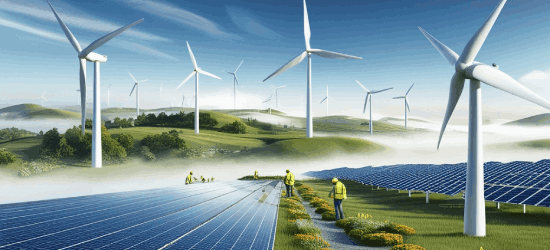India charts bold renewable energy future with 500 GW target by 2030

By Team Indoen
Posted on 18 Feb 2025
New Delhi: India is forging ahead with its ambitious target of achieving 500 GW of renewable energy capacity by 2030, as reaffirmed by industry leaders at the recently concluded India Energy Week 2025. The event served as a crucial platform for discussions on the nation’s clean energy transition, with a strong emphasis on biofuels, solar, wind, and green hydrogen as key components of a sustainable energy landscape.
The session on "Scaling Renewables and the Advanced
Energy Solutions Landscape" featured leading experts, including Gurdeep
Singh, Chairman & MD of NTPC, Sushil Purohit, CEO of Gentari, Gaurav Gupta,
Additional Chief Secretary of Karnataka’s Department of Energy, Rahul Munjal,
CMD of Hero Future Energies, and Amit Singh, CEO of Adani Green Energy. Their
discussions cantered on India's renewable energy leadership, strategic
initiatives, and the hurdles in large-scale implementation.
India’s leadership in renewable energy
Gurdeep Singh reaffirmed NTPC’s commitment to transitioning
beyond thermal power, highlighting significant investments in solar and nuclear
energy to support India’s clean energy mission.
Highlighting India’s growing influence, Sushil Purohit noted
the country’s leadership in the Asia-Pacific region, particularly in solar and
wind energy deployment.
Amit Singh elaborated on Adani’s 20 GW solar and wind energy
project in Gujarat, stressing the necessity of a robust domestic supply chain
to reduce reliance on imports. He advocated for greater industry collaboration,
talent development, and localized supply chains to accelerate clean energy
adoption.
The role of green hydrogen and AI in energy transition
With green hydrogen gaining traction as a future fuel, the
discussion emphasized its potential role in the clean energy transition.
However, cost efficiency remains a significant challenge.
Gaurav Gupta underscored the need for technological advancements to drive down
expenses and make green hydrogen viable for large-scale adoption.
Further expanding on technology-driven solutions, Amit Singh
highlighted plans to establish AI-driven data centres in regions with
affordable renewable energy, ensuring sustainable power sources for the growing
digital economy.
Addressing implementation challenges
Key obstacles such as land acquisition and grid integration
were also in focus. Gaurav Gupta identified land constraints as a major
barrier, while Gurdeep Singh emphasized the urgent need for grid infrastructure
upgrades to accommodate the fluctuating supply of renewable energy.
NTPC is actively investing in large-scale transmission
infrastructure to support states like Gujarat, Rajasthan, Madhya Pradesh, and
Chhattisgarh in their renewable energy initiatives. Strengthening grid
connectivity is crucial for the seamless integration of renewables into the
national power network.
A call for youth-driven innovation
As India progresses towards its renewable energy goals,
industry leaders emphasized the need for innovation led by the younger
generation. Encouraging youth participation, the session concluded with a
strong emphasis on the role of research, innovation, and policy advocacy in
accelerating the energy transition.
India Energy Week 2025 played a pivotal role in reinforcing this commitment. Within just two years, the event has grown into the world’s second-largest energy conference, reflecting India’s expanding role in shaping the global energy landscape. The next edition, scheduled for February 2025 in New Delhi, is expected to further strengthen international collaboration toward a cleaner, more sustainable future.
Kindly follow us for updates on:
- India’s renewable energy boom: Driving growth and green jobs
- India’s solar energy revolution: A path to 500 GW by 2030 and beyond
- Solar-powered farming: Experts call for scaled investment and policy reform
- Affordable clean energy key to India's accelerated energy transition
- Unlocking Investments To Achieve India’s 500 GW RE Target
- India Strengthens RE Storage with 10 GWh Battery Manufacturing Boost
- India Energy Week 2025: Highlighting India’s growing energy leadership
- Trump’s tariff war with China could brighten India’s solar prospects
- India’s solar share to soar, RE set to power 27% of energy mix by 2027
- Major deals, energy policy shifts announced at India Energy Week 2025